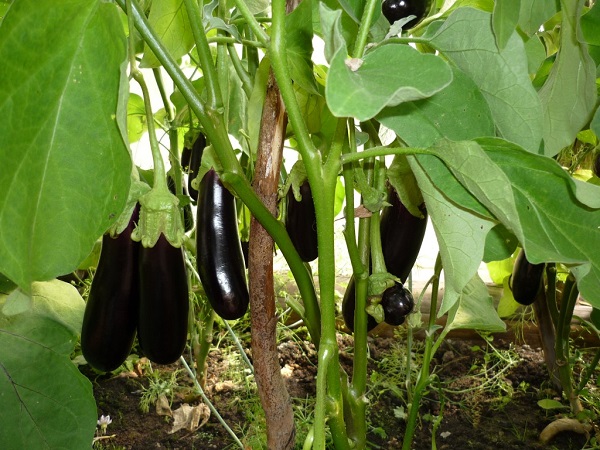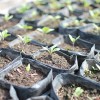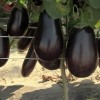The reasons why eggplant leaves turn yellow?
Content
Lack of nitrogen
First of all, yellowing of eggplant leaves can be associated with a lack of nitrogen compounds in the soil. Especially if the lower leaves on the bush turn yellow. Despite the fact that the different nature of yellowing may also indicate a lack of potassium, copper, iron, be sure that nitrogen fertilization of the soil should be carried out. The trick is that nitrogen helps the plant to distribute all the useful microelements available in the reserve and absorbed during the growth process in different parts of the bush. Consequently, the lack of nitrogen forces the plant to use the resources as needed.
It is important to maintain a balance of mineral and organic fertilizers to prevent yellowing or disease in the eggplant.
Changes to conditions
Eggplants cannot be called a very capricious culture, but they react quite sharply to a change in living conditions - first of all, with yellowing of the leaves. If you have already asked the question "Why do eggplant leaves turn yellow?" - means the plant has already expressed its displeasure.
By yellowing, eggplant reacts to many things. For example, too high an air temperature leads to the formation of burns on the leaf plate, it turns yellow and dries up. With a lack of moisture in the air and soil, the leaves curl and then fall off.
It should be understood that if the eggplant seedlings turn yellow after you have transplanted them into open ground, this is a natural process. The plant needs to acclimatize, get used to new conditions, put down roots in new soil. For such cases, it is important to prepare a good soil composition, fertilize it and carefully care for the eggplant greens so that they quickly take root in a new place.
What to do in case of yellowing?
So what should you do if the eggplant leaves dry and wither? Preparation should begin with growing seedlings so that an adult plant does not face this problem. Process and harden the seeds to awaken in them all the vegetative processes necessary for rapid growth, as well as to develop immunity against the invasion of fungal microflora. When planting seeds in pots, make sure that the soil is well fertilized with nitrogen, mineral and, if desired, organic fertilizers. It is worth doing this for the complex development of eggplant, when both whips, leaves, inflorescences, and fruits grow equally well.
If yellowing overtook the eggplant seedlings, spots appeared on the leaves, then perhaps this is a symptom of a burn. With abundant illumination, both the sun and ultraviolet lamps, the cellular structure of delicate eggplant leaves is destroyed and necrotic. Try shading or shortening the daylight hours for the seedlings slightly, thus preventing new burns. Also, when watering, try not to pour water on the leaves, since water droplets become lenses, refracting and amplifying the rays of light.
Yellow spots along the edges of the leaves indicate a lack of potassium.Top up with potash and the spots will disappear within a few days. In other cases, carry out foliar dressing with a complex of mineral and organic fertilizers that always contain nitrogen.
One of the reasons why the lower and upper leaves of eggplant turn yellow is watering with cold water. This should not be allowed under any circumstances. Due to the fact that the water temperature is much lower than the soil temperature, the eggplant root system takes noticeable damage, freezing and then rotting. This is what negatively affects the structure and color of the plant.
Often, the cause of yellowness lies in the soil in which both seedlings and young seedlings are grown - peat soil is not able to provide eggplants with enough micronutrients. Therefore, when growing a plant on peat soil, it is important to provide vegetables with a complete set of fertilizers so that they do not wither from a lack of useful microelements.
Video "Ways of growing eggplant"
Experienced gardeners give advice on how to care for your eggplant.
What to do when curling leaves
If the eggplant leaves are curled, then you should postpone all your business and start saving the plant. There are several types of curling: when the leaf rolls up into a tube, when the leaf rolls down into a tube, when the leaf rolls up into a tube towards the stem. Be that as it may, this means that it lacks nutrients, it is afflicted with a disease, harmful insects interfere with normal vegetation, and the conditions of detention are violated.
If you have not yet carried out top dressing this season, then you should do it immediately. Eggplants get all the necessary nutrients from potassium compounds (potassium nitrate, potassium sulfate), superphosphate, ammonium nitrate.
As the first feeding, you can use a solution of potassium nitrate (30 g of fertilizer is diluted in 10 liters of water), or use the drug "Kemira-Lux" (25-35 g of the drug is diluted in 10 liters of water). For the second feeding, you can use a complex of different fertilizers, since it falls just at the very peak of the growing season, on the eve of the flowering period: mix 30 g of foskamide, 15 g of superphosphate, 1 teaspoon of ammonium nitrate, 2 teaspoons of potassium sulfate in 10 liters of water ... Water at the rate - 1 liter of solution for 1 eggplant bush.
If you have already carried out the main fertilization of the soil, then the complex of mineral and organic substances will only harm the plant. You can use folk remedies: infusion of onion husks (0.5 liters of husks are infused in 3 liters of water, filtered before use), whey (1 liter of yoghurt is diluted with 1 liter of water, insisted for 3 days, filtered before use) or a solution based on dry or "live" yeast (10 g of dry yeast is diluted in 10 liters of warm water, infused for 2-3 days, then diluted 1:10 and watered the beds; 100 g of "live" yeast is infused in 10 liters of warm water for 2-3 days, filter and dilute 1:10 before use).
Other reasons include a lack of lighting. This can be caused by cloudy, rainy weather or excessive thickening of the plantings. In the first case, it is worth turning on the fluorescent lamps, in the second, pinching the eggplant to give light to all the leaves.
Frequent watering, especially with cold water, damages the plant. It is better to water less often, but with warm water.
If insects or fungal diseases are the cause of twisting, then it is necessary to carry out surgical treatment of the plant. Treat with fungicidal preparations, milk serum, soapy water or garlic infusion.
Video "How to feed eggplants?"
This video talks about natural fertilizing for eggplant seedlings.





